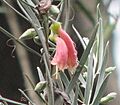Eremophila youngii facts for kids
Eremophila youngii is a beautiful flowering plant that belongs to the figwort family. It grows only in Western Australia, which means it is endemic to that area. This plant is a bushy shrub with many parts covered in grey or yellowish scales. It produces lovely pink, purple, or red flowers.
Quick facts for kids Eremophila youngii |
|
|---|---|
 |
|
| Eremophila youngii subsp. youngii leaves and flowers | |
| Scientific classification | |
| Genus: |
Eremophila (plant)
|
| Species: |
youngii
|
| Synonyms | |
|
|
Contents
What Does Eremophila youngii Look Like?
Eremophila youngii is a tall, bushy shrub that can grow between 1 and 4 meters (about 3 to 13 feet) high. Its branches, leaves, and flowers are often covered with tiny, flat, grey or yellowish scales. These scales can sometimes fall off as the plant gets older.
The branches feel rough because of old leaf bases and have small, bumpy spots. Its leaves grow in pairs, one across from the other. They are long and narrow, usually about 2.4 to 4.5 centimeters (1 to 1.8 inches) long and 0.2 to 0.55 centimeters (0.1 to 0.2 inches) wide. Each leaf has a clear line down the middle on its underside.
The Flowers of Eremophila youngii
The flowers grow either alone or in pairs where the leaves meet the stem. They sit on short stalks, about 0.2 to 0.35 centimeters (0.1 to 0.14 inches) long. Each flower has five sepals, which are small, hairy, and shaped like a spear or triangle. They are about 0.2 to 0.55 centimeters (0.1 to 0.2 inches) long.
The petals are joined together at the bottom to form a tube, about 1.8 to 3 centimeters (0.7 to 1.2 inches) long. This petal tube can be pink, purple, or red. It is usually hairy both inside and out, though the inside has longer, softer hairs. The four stamens, which are the parts that produce pollen, stick out beyond the end of the petal tube.
After the flowers bloom, a dry, cone-shaped or oval-shaped fruit appears. It is about 0.8 to 1.1 centimeters (0.3 to 0.4 inches) long and has a papery covering. The time when the plant flowers depends on its specific type, called a subspecies.
How Eremophila youngii Got Its Name
The plant was first officially described in 1876 by a scientist named Ferdinand von Mueller. He based his description on plant samples collected by Jess Young. Young found these samples near Queen Victoria Spring in May 1875, during an expedition led by Ernest Giles.
The name youngii was chosen to honor Jess Young, who collected many different plant samples during that trip.
Different Types of Eremophila youngii
There are two main types, or subspecies, of Eremophila youngii:
- Eremophila youngii subsp. youngii: This type usually flowers between June and October. Its petal tube and fruits have branched hairs on the outside.
- Eremophila youngii subsp. lepidota: This type flowers between January and September, usually after it rains. Its petals and fruits are covered with scales.
Where Eremophila youngii Grows
The subspecies youngii is found in many different places across Western Australia. It grows in areas between Kalgoorlie and Exmouth. You can find it in several biogeographic regions like Carnarvon, Gascoyne, Gibson Desert, Great Victoria Desert, Little Sandy Desert, Murchison, and Yalgoo.
The subspecies lepidota is much harder to find. It grows on flat clay areas and floodplains between Newman and Exmouth. It can be found in the Carnarvon, Gascoyne, Little Sandy Desert, and Pilbara biogeographic regions.
Protecting Eremophila youngii
The Western Australian Government's Department of Parks and Wildlife keeps track of how many of these plants exist.
- Subspecies youngii is considered "Not Threatened," meaning there are enough of them, and they are not in danger.
- Subspecies lepidota is listed as "Priority Four." This means it is rare or close to being threatened, so it needs to be watched carefully.
Growing Eremophila youngii in Gardens
This type of eremophila plant has been grown in gardens across Australia for many years. It is a strong and reliable shrub that works well in larger gardens. It produces many brick-red or dusky pink flowers, which are also attractive to birds that feed on nectar.
It is easy to grow new plants from cuttings. This shrub can grow in most types of soil, even heavy clay, and it likes full sun or partial shade. It does not need much water, even during long dry periods, and can handle very cold temperatures.
Images for kids
-
E. youngii subsp. youngii growing near Shark Bay
-
E. youngii in Maranoa Gardens, Victoria



